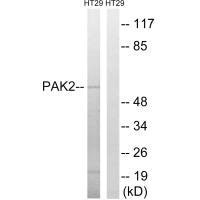
Western blot analysis of extracts from HT-29 cells, using PAK2 (Ab-197) antibody.
PAK2 (Ab-197) Antibody

CSB-PA827528
ApplicationsWestern Blot, ELISA
Product group Antibodies
ReactivityHuman
TargetPAK2
Overview
- SupplierCusabio
- Product NamePAK2 (Ab-197) Antibody
- Delivery Days Customer20
- ApplicationsWestern Blot, ELISA
- CertificationResearch Use Only
- ClonalityPolyclonal
- ConjugateUnconjugated
- Gene ID5062
- Target namePAK2
- Target descriptionp21 (RAC1) activated kinase 2
- Target synonymsgamma-PAK; p21 (CDKN1A)-activated kinase 2; p21 protein (Cdc42/Rac)-activated kinase 2; p21-activated kinase 2; p58; PAK-2; PAK65; PAKgamma; S6/H4 kinase; serine/threonine-protein kinase PAK 2
- HostRabbit
- IsotypeIgG
- Protein IDQ13177
- Protein NameSerine/threonine-protein kinase PAK 2
- Scientific DescriptionSerine/threonine protein kinase that plays a role in a variety of different signaling pathways including cytoskeleton regulation, cell motility, cell cycle progression, apoptosis or proliferation. Acts as downstream effector of the small GTPases CDC42 and RAC1. Activation by the binding of active CDC42 and RAC1 results in a conformational change and a subsequent autophosphorylation on several serine and/or threonine residues. Full-length PAK2 stimulates cell survival and cell growth. Phosphorylates MAPK4 and MAPK6 and activates the downstream target MAPKAPK5, a regulator of F-actin polymerization and cell migration. Phosphorylates JUN and plays an important role in EGF-induced cell proliferation. Phosphorylates many other substrates including histone H4 to promote assembly of H3.3 and H4 into nucleosomes, BAD, ribosomal protein S6, or MBP. Additionally, associates with ARHGEF7 and GIT1 to perform kinase-independent functions such as spindle orientation control during mitosis. On the other hand, apoptotic stimuli such as DNA damage lead to caspase-mediated cleavage of PAK2, generating PAK-2p34, an active p34 fragment that translocates to the nucleus and promotes cellular apoptosis involving the JNK signaling pathway. Caspase-activated PAK2 phosphorylates MKNK1 and reduces cellular translation. Martin G.A.,EMBO J. 14:1970-1978(1995). The MGC Project Team;Genome Res. 14:2121-2127(2004). Olsen J.V.,Cell 127:635-648(2006).
- ReactivityHuman
- Storage Instruction-20°C or -80°C
- UNSPSC12352203
